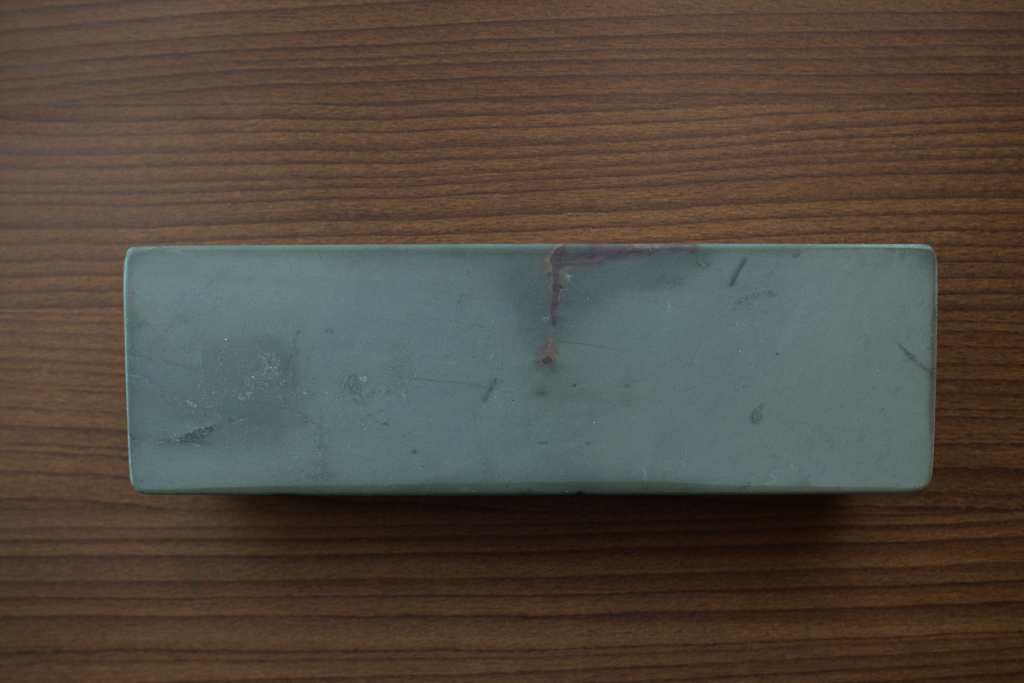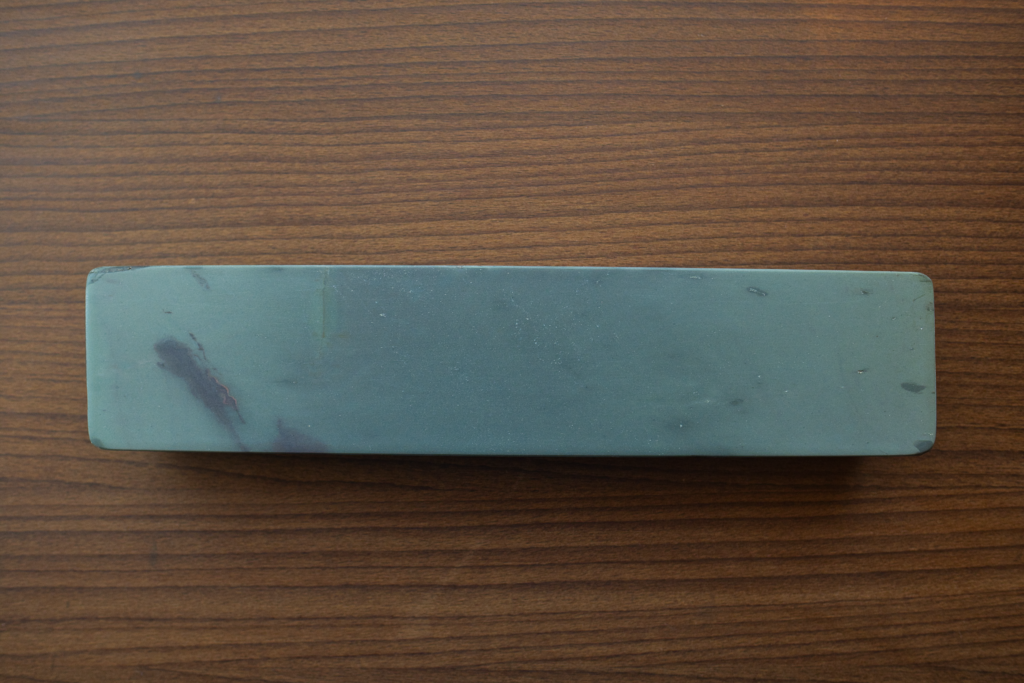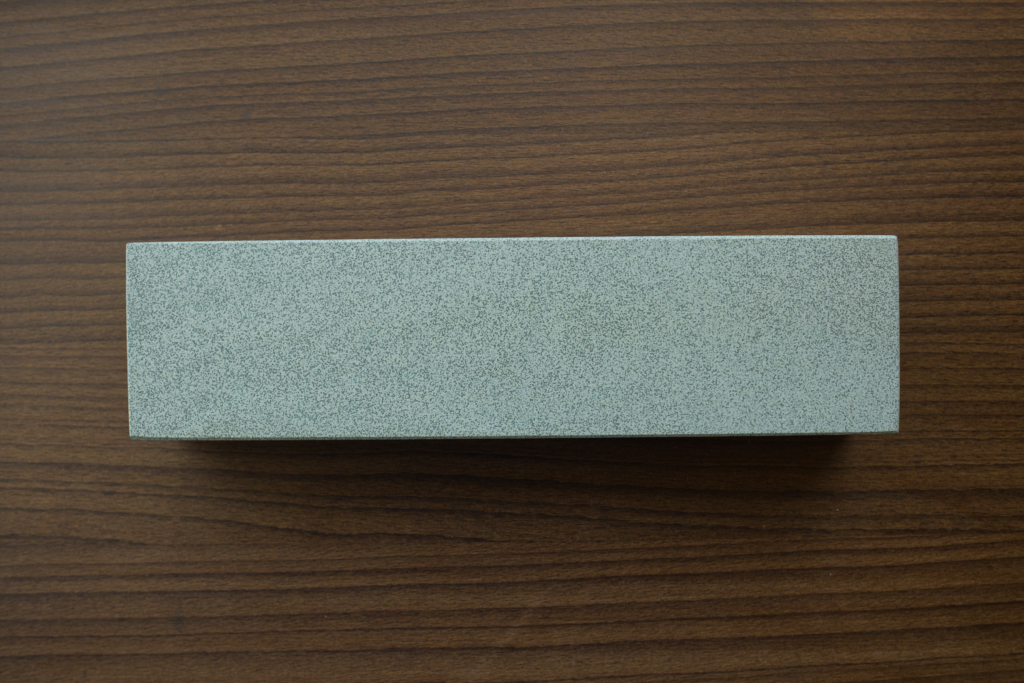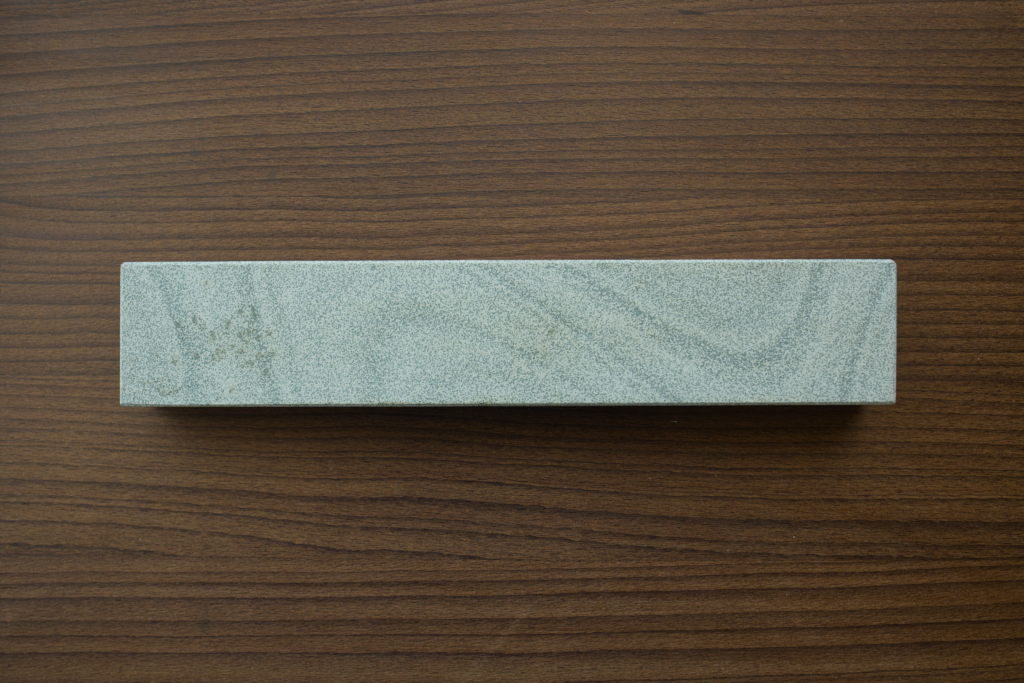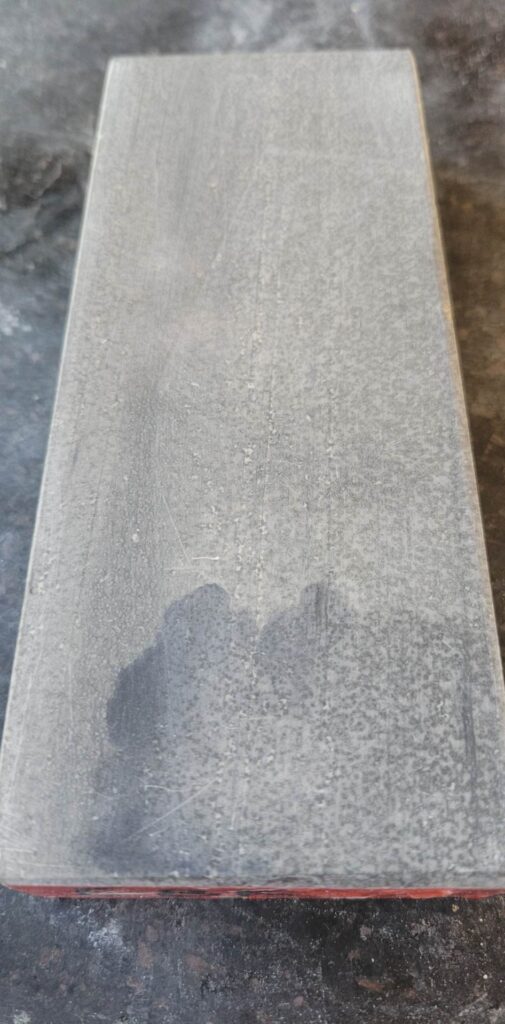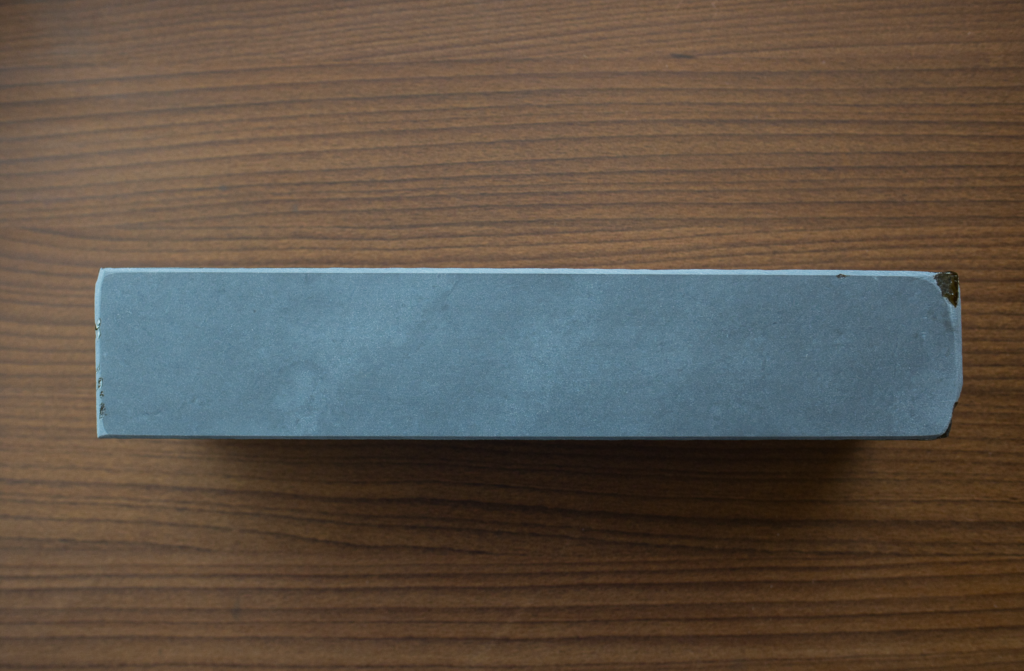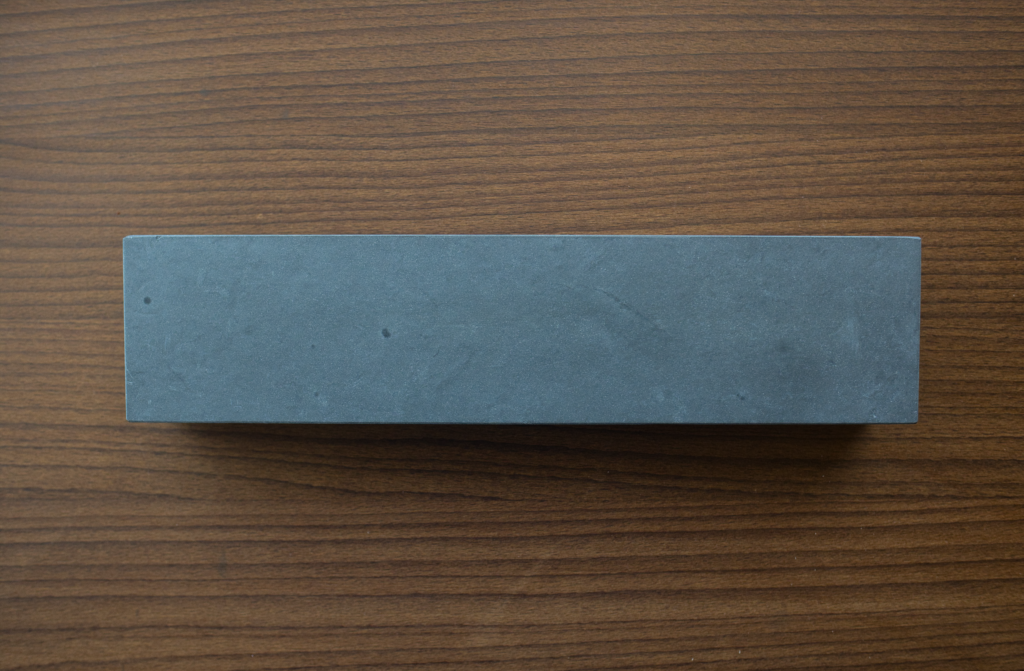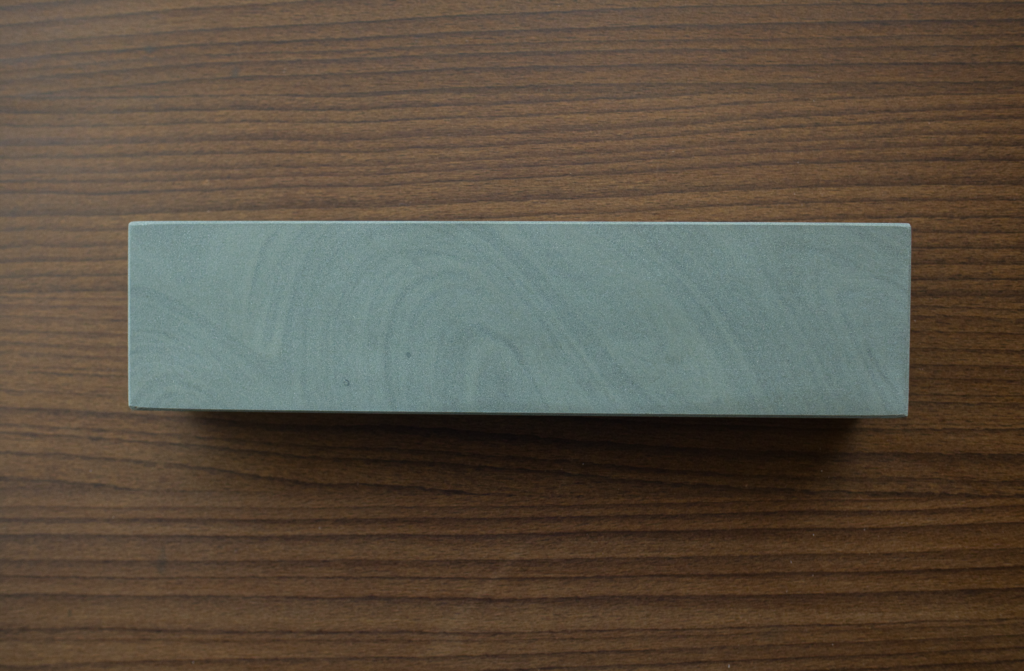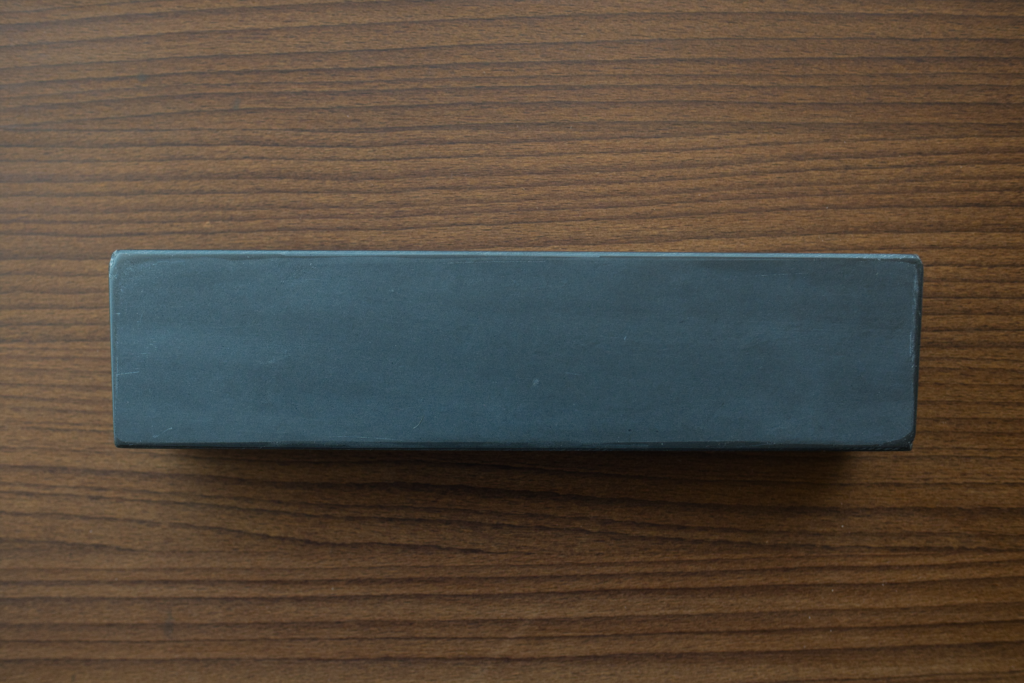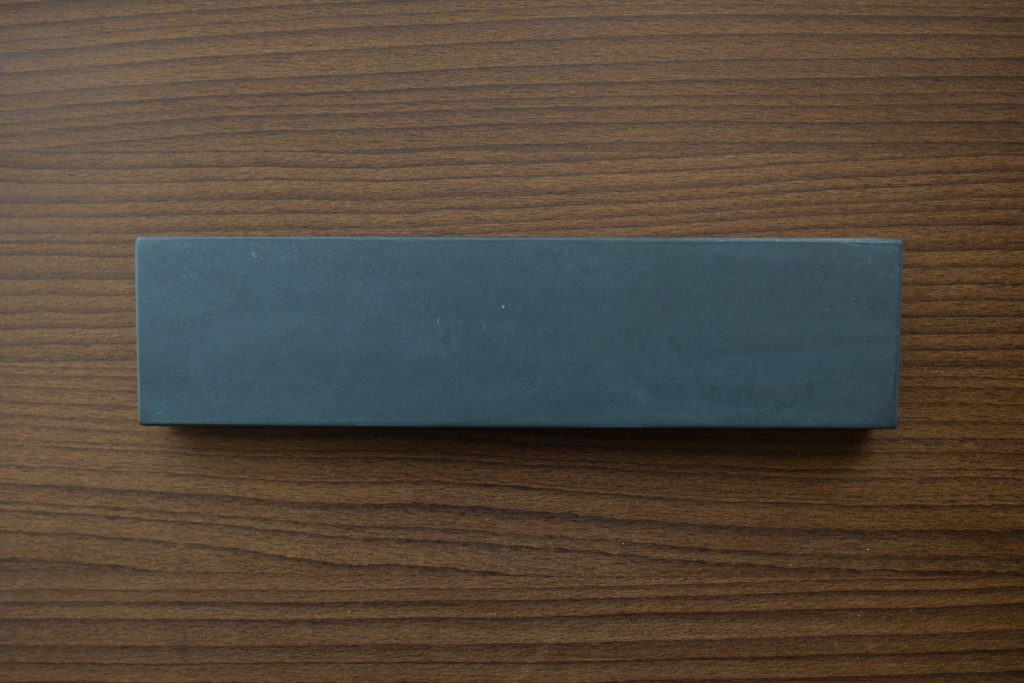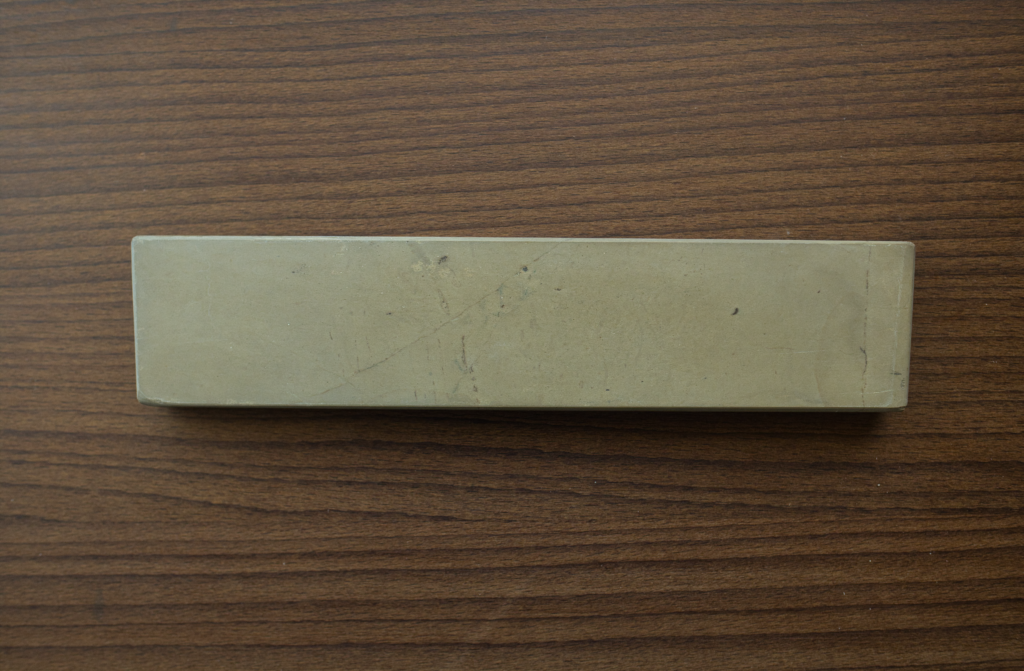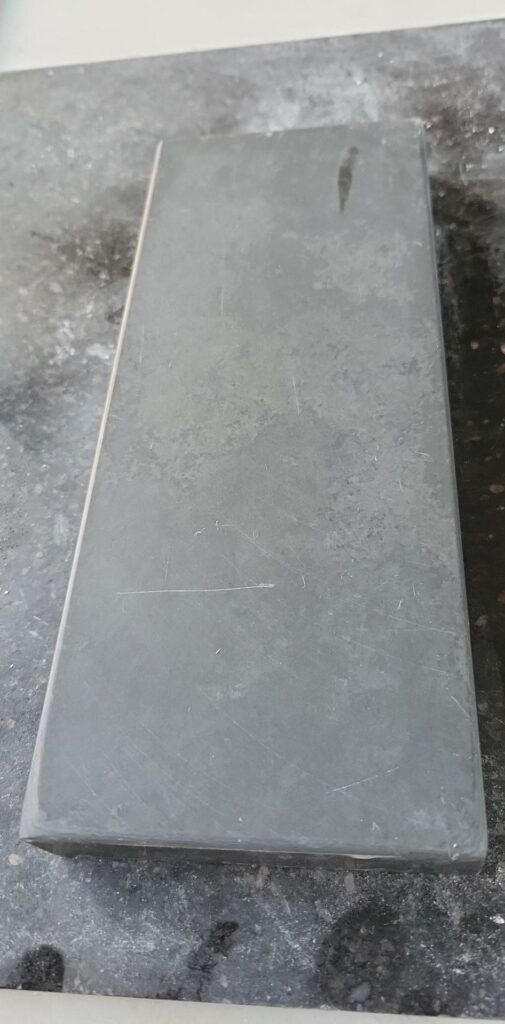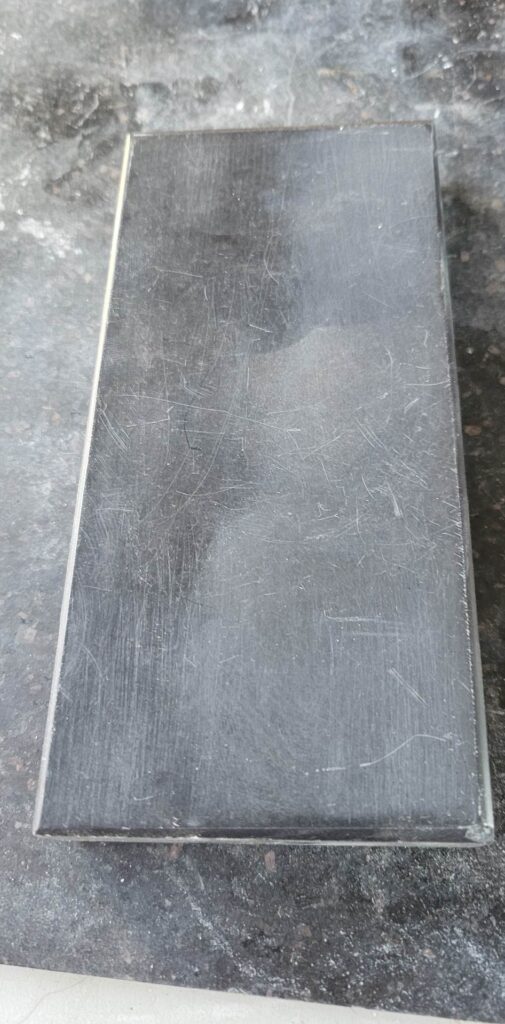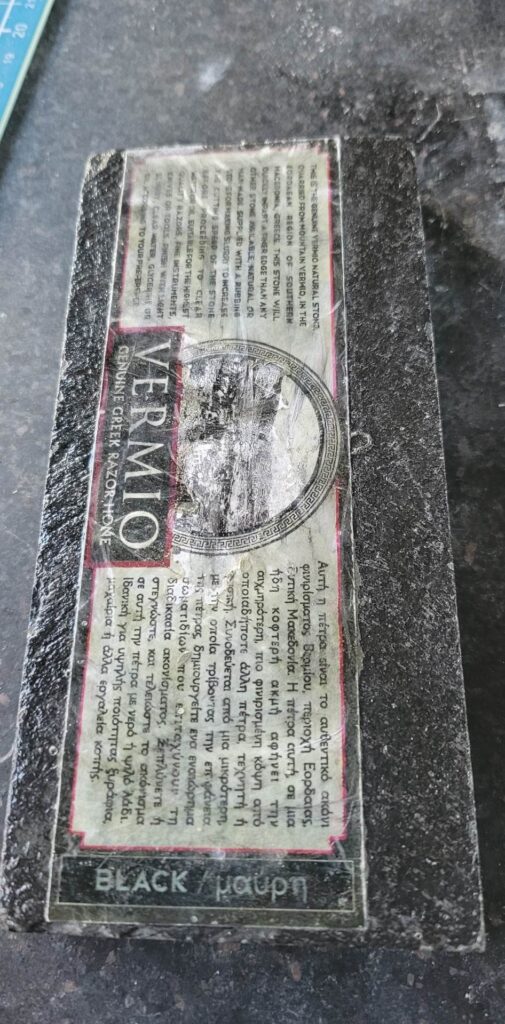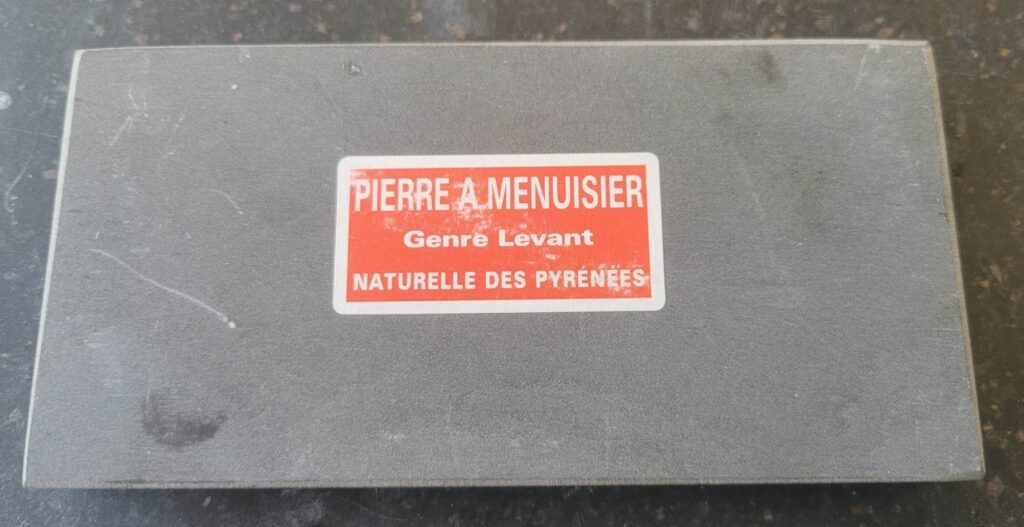European natural stones use hones and sharpening stones date back to antiquity with many of the mines in Europe being some of the oldest exploited deposits of stone on record such as the Cretan / Turkish Stone. Their performance and variety can be equal to Japanese natural stones but tends to be less methodically documented and labelled, instead being a conglomeration of regional stones with a few varieties that expanded past regional notoriety and distribution. Information on European natural stones tend to be more difficult to find and can be scarce about certain variants, but we know a great deal about them in this modern age and new information is still often found in old manuals and journals still being rediscovered. One of the major differences between European natural stones and Japanese natural stones is the lack of focus on polishing performance of the stone, and usually a much greater focus on sharpening / honing capabilities. Additionally, many of these stones are meant for and perform best with oil as well. For any enthusiast of natural whetstones, these offer new and exciting options beyond the more popular and documented JNAT stones.
Sections
Coticules, Belgian Blue Whetstones, La Lorraine (Belgium)
Thuringian Waterstone / Escher (Germany)
Charnley Forest Hone (UK)
Tam O Shanter Scotch Hone (UK)
Water of Ayr Scotch Hone (UK)
Cretan / Turkish Oilstone (Greece)
Yellow Lake Oilstones / Welsh Slate / Dragons Tongue (UK)
Llyn Idwals & Grecian Hones (UK)
Dalmore Blue & Dalmore Yellow (UK)
Silkstones (UK)
La Lune (France)
Pierre Du Sud Ouest (France)
Penrhyn Heather Slate Hones (UK)
Rozsutec (Slovakia)
Green Shadow / Black Shadow (France)
Vermio Hone (Greece)
Glanrafon Hone (UK)
Pyrenees / Pierres Stone (France)
Frankonian Hone (Germany)
Saxonian Oilstone (Germany)
Fiddich River Stone (UK)
Bentheim & Gildehaus Stone (Germany)
Spiegelberg Whetstone (Germany)
Gwespyr Stone (UK)
Moughton (UK)
Note: Specific Gravity (SG) ranges are listed for stones here mainly to help identify them. One stone having lower SG than another doesn’t always mean it will be softer than the higher SG stone. Many stones from Europe (specifically UK) can be hard to identify, and SG ratings helps to narrow it down if you can measure them. Always keep in mind SG is a measure of density, not hardness or fineness.
Coticules, Belgian Blue Whetstones, La Lorraine (Belgium)
Information regarding Belgian whetstones has been expanded into its own page. Check here for more information on these stones.
Thuringian Waterstone / Escher Hone (Germany)
Information regarding Thuringian Waterstones and Escher Hones have been expanded into its own page. Check here for more information on these stones.
Charnley Forest Hone (UK)
These are novaculite stone which come from Mount Sorrel quarries, the two most famous being Thringston Village and Whittle Hill. The area these were pulled from are now a protected “Natural England National Character Area” and no stone will be pulled from them again. Sometimes also called Leicestershire Oilstones, Cutlers Oilstones, or Chorley Stone. The stone was held in high regarding during the 1600s as a superior grade stone to much else available in the surrounding area of Cole Orton. It was very difficult to mine and as such did not get much regard at the time on the international export. It was also considered inferior to the Arkansas stone by many vendors. There is a great deal of Charnley stones which easily rival the best Arkansas, but it was (and still is) far easier to ensure you get a great Arkansas stone rather than having to “find a good razor quality Charnley”. It is hard to say when the last (Whittle) quarry closed down, but the best guess is the early 1900s.
These stones are very fine grit (10k+) but can have a reputation of being slower cutting than the more widely available and similar Arkansas and Cretan stones. Often the Charnley Forest hones have a higher specific gravity than their Arkansas and Cretan counterparts, and as such can be used like those stones (with oil, or water and a conditioned sharpening surface) or with a slurry that you slowly dilute overtime (like a Coticule). Similar to Coticules though, you must dilute the slurry very slowly as if you move too fast you will not end up with a satisfactory edge. Most who use Charnley Forest hones prefer the oil or water/conditioned surface honing methods though you should experiment to see what you like the most.
These have a blue-green-grey hue to them along with characteristic red striations, stripes, or dots throughout the stone. Stones from Whittle Hill are the most sought-after variety, often being more irregular in shape or rounded on the bottom though it can be difficult to tell – often looking trapezoidal in shape with the largest face being the sharpening surface. The non-Whittle Hill stone are often a bit softer and lighter in color and more likely to have “Khaki”-like colored areas and more splotchy red spots.
They can usually be divided into a few categories that old manuals discuss:
- Green-Blue with Red Lines
- Light Olive Green or Khaki
- Green with Black or Red Dots.
- The dots are small and plentiful. It may also have characteristic Red lines.
- Green with Layering
- When wet, single layer appears underneath surface in another direction.
- Green with Multiple Layers
- Same as above but multiple directions are present underneath when wet.
Stones should be closely evaluated as the darker ones are considered better, but the dark areas can also have dark inclusions in them that are harder than the rest of the stone. Inclusions may not always be toxic (harder than surrounding stone) and each must be tested. Old manuals suggest that the solid green versions which are darker with less or no lines are the best versions – but versions of each can be exceptional. Specific gravity tends to range in the 2.62-2.75 range. The closer the SG is to 2.65 the more likely the stone is to a purer concentration of Quartz Crystals and thus a “finer” specimen. Often coarser Charnley Forest Hones have a high SG rating due to inclusions.
Tam O Shanter Scotch Hone (UK)
Sometimes called the Scotch, Snakestone Hones, Montgomerie Stone Hone, Soutar Johnny Stone or Pierre Rouge, these along with the Water of Ayr could be considered the classic main whetstone of the United Kingdom dating back to the 1700s. The Tam O Shanter organization also retailed other stones under their own name such as the Dalmore Blue, Dalmore Yellow (Mikado). The Water of Ayr (WoA) stones and Tam O Shanter stone are related and from the same company and were briefly sold under the same Tam O Shanter name leading to some confusion. They originate from different mines and have since been delineated with the “Tam O Shanter” being used to refer to the variety of stones which are speckled, less fine, and softer. This speckled stone is also sometimes referred to as the “White” variety. These come from the Dalmore quarry. Tam O Shanter hones are analogous to an 8k stone and often function as a pre-finisher to finishing stone depending on the variety you have. Though these can be oil stones, they were originally suggested to be used with water or saliva and some labels even suggested against the use of oil. Specific Gravity tends to be in the range of 2.5 to 2.60.
They can usually be divided into a few categories, first broken down by official labels than more “understood” divisions by the mine owners and enthusiasts:
- “Standard” Tam O Shanter Hone – These are the most common stones, and when they are labelled just have a standard ToS label on them.
- Blue Version (Harder, Coarse, Speckles which are sometimes Circles) – Semi-Common, wide variety of Sizing
- Grey to Light Grey (Soft, Semi-Fine, Dense Standard Speckles) – Common, wide variety of Sizing
- “Fine” Tam O Shanter Hone – These are uncommon stones and came in boxes labelled Fine or with an F on them. Without a label they can be easily mistaken for a Standard without testing.
- Grey to Light Grey (Softest, Fine, Dense Standard Speckles) – Rare, often in Small Bench Sizing (6x1x.5 or 8x2x1)
- “White” Tam O Shanter Hone – There are uncommon stones and came labelled as White, but only sometimes. Many were sold without labels to specific industries for surgical or horological work.
- White (Soft, Very Fine, Standard Speckles or Less Dense Speckling) – Rarest, often in very small Sizing
- Bright White (Hard, Very Fine, Standard Speckles or Less Dense Speckling) – Semi-Common, often in Razor Hone Sizing
Water of Ayr Scotch Hone (UK)
The other side of the Tam O Shanter / Water of Ayr coin, this is the darker, finer stones produced by Tam O Shanter which will have no speckling and be dark grey in color. In France these were referred to as the Pierre Rouge stone. There are two version of the Water of Ayr stone, one from the Meikledale quarry (the original) and a later version produced from the Enterkine quarry. The Meikledale quarry version will be a big darker colored than the Enterkine version and often has blotchy black spots on it. These are not the same type of speckling as we see in the TOS stones and the spots look very different, often like 5-20 drops of ink on the surface of the stone. The Enterkine quarry WoA (sometimes called the Dark Blue, Blue Water of Ayr, or Ayrshire stone) will lack these dots. Furthermore, when attempting to determine which version you have, the Meikledale quarry version will slurry a inky black whereas the Enterkine quarry version will slurry a light blue-grey similar to a Thuringian.
Water of Ayr (pronounced Air) are preferred for razors over the other Tam O Shanter hones and are substantially more rare. These stones were produced in lower quantities than the speckled Tam O Shanter stones and were the first stone variety Tam O Shanter started selling. Unfortunately, Water of Ayr stones have a tendency to crack or split and should be sealed up like a JNAT (sides and back) to help avoid teh issue. Though these are oil stones, they were originally suggested to be used with water or saliva. Thse are analogous to a 10-12k stone. Specific gravity tends to be around 2.7-2.75 range.
Cretan / Turkey Oilstone (Greece)
Information regarding Cretan / Turkey Oilstones has been expanded into its own page. Check here for more information on these stones.
Yellow Lake Oilstones / Welsh Slate / Dragons Tongue (UK)
Information regarding Yellow Lake Oilstones / Welsh Slate / Dragons Tongue whetstones has been expanded into its own page. Check here for more information on these stones.
Llyn Idwals & Grecian Hone (UK)
From the quarry near Bethseda Wales, this novaculite stone can be similar in use and look to the Charnley Forest stones, but usually more bluish and without the red streaks and in their place usually black lines or dots. These started coming into popularity when you could no longer dig Charnley hones out of the ground. It often has a reputation for being a bit harder but not as fine as the Charnley Forst stones and has been in circulation since the 1790s. They are typical blue or blue green with various swirls or patterns within, often accompanied by black speckles or dots. Llyn Idwal have been historically more expensive and as such less pervasive in the market. Despite being harder, they are considered a bit lower in grit and more aggressive than the Charnley (but slow as far as stones go in general). It is a novaculite stone – again similar to the Charnley – though in use it behaves much more like an Arkansas novaculite stone would where the slurry is aggressive, and the surface conditioning is of critical importance to the blade’s performance. It was at one time sold by Salmen as a different type of Yellow Lake Oilstone, and any “blue colored” Yellow Lake stone would be a Llyn Idwal. These stones can finish razors but are at the coarser end of that range and benefit from oil use. They also seem to perform and look very similar to much of the Vermont Slate coming from the US. Specific gravity tends to be 2.65 to 2.83 range.
Grecian hones are at least related to or may be a type of Llyn Idwal stone and may have come from the same region or even quarry. The two usually look and feel quite similar but with minor differences, with the Grecian hone being softer, coarser/faster, and typically of more solid coloring with less swirling patterns within the stone.
It seems likely that this was a way of selling the same origin stone but differentiating the qualities of the stone. It may be better to view them as a spectrum of the same origin stone. As such, usually we call one stone a Llyn Idwal if it is harder and finer, and a Grecian if it is softer and coarser. Grecian hones will be lower on the specific gravity range more in the 2.6 range.
Dalmore Blue & Dalmore Yellow Hone (UK)
Quarried in Craiksland, Ayshire this stone was sold through Tam O Shanter but not mined by them. These are a fine sandstone which is analogous to the x1k-x3k grit range and considered a bevel settter for razors or good knife/tool stones. They tend to have a very characteristic swirling layering to their visible surface of the stone and are very easy to identify. It has a light and dark blue structure which can sometimes show as greenish or greyish. To reach the higher end of the spectrum they will need to be used with oil. Specific Gravity tends to be in the range of 2.55 to 2.60.
Far less popular than the Dalmore Blue, the Dalmore Yellow is a coarser stone with a yellow/tan color and lacks the banding of its Dalmore Blue sibling. It is a soft sandstone with an analogous grit range of x800, so very aggressive comparatively and much more of a tool stone. These can work well as a bevel setter, though are fairly rare to find. These rare easier to find in the Tam O Shanter combination dual hones, but still not super common.
Silkstones Hone (UK)
A somewhat similar stone to the Welsh Slate above, there are differences though in how it looks/feels/performs comparatively. A good chance this is the same Silkstone that comes from the Sheffield area, specifically Dronfield is where it seemed some small quarries were. This seam though runs through Whiteland, Gleadless, Norfolk Park, and then descends into the Sheffield Valley. Unlike other stones, it is very hard to determine this stone’s exact location in the UK and this is – thus far – a best guess. It tends to be a bit less abrasive, more reflective at the surface, and provide more feedback than the Welsh Slate / Yellow Lake family of stones. The color is also usually darker, more of a grey black comparatively. Silkstones by name were only officially produced by Cambrock, though it is highly likely AB Salmen also put out a Silkstone product based on comparisons of stones by the community. The analogous grit of Silkstones is similar to Yellow Lake as well, maybe being a tad bit higher than the 10k-12k+ range and similarly get to the higher end through use of oil – but water is still viable for functional use.
La Lune Hone (France)
This is a sedimentary slate which is typically a wine red/purple color but sometimes can have green mineral spots of Chlorite throughout. They are analogous to a high grit stone (10k+) and are known for being a little faster than average slate and nice to use as finishers for razors or knives. A group of individuals has recently (2021) started bringing this stone back to the market under a similar but revised name and logo. Specific gravity tends to be in the 2.8+ range. Background is below:
It was in Fumay that the slate trade unionist Albert Anciaux (1896-1978) specialized in cutting slate in the form of whetstone, after having worked with Lorent Bouvy in Haybes. He worked there until the 1970s before handing over to his son-in-law, Robert Cantin (1927-2012). The workshop, located at a place called the Village nègre (Saint-Gilbert gap) closed in 1984, it is still visible today under the responsibility of the municipality.
While some of the stones produced were distributed locally, most of the production was intended for the company “F.Ghelfi & Cie Birolleau reunited”, specialist in “Manufacturing & Assembly of Grinding Wheels, Stones for Sharpening and Polishing”. The sharpening stones produced in Fumay join a catalog made up of stones originating from several regions and marketed under the common name of “Pierre la Lune”. We are talking about more than 50 tons of stones produced at the time.
The modern trademark and old stock from when the workshop closed down in 1985 has been more recently acquired by Nicolas Rollin who has brought this stone back onto the market. This “new stone” is the same stock as the old stone but cut to a more modern standard/dimensions and with a similar but updated label.
Pierre Du Sud Ouest (France)
Sometimes called a “French Thuringian” for its similar use and functionality as a razor hone. It does not share any geological commonality to the actual German Thuringian stone, originating from different geological formations and regions. The stone is commonly a light tan and never gained any real traction as a commercially exported stone. It was however very common in France for some time and secondhand versions come up in the market.
Penrhyn Heather Slate Hones (UK)
Stock for this comes from northern Snowdonia and seems to be primarily for the local market. There are primarily two versions, the Ruby and the Grey though both are a distinct purple color. They tend to perform below the Alberllefenni slate but are still viable razor hones and as like other Welsh Slate can be used with oil to achieve an extra step in fineness. One of the tell-tale signs of this are green dots (or lines) being present within the hone. Additionally, the purple on both the Ruby and Grey versions will be a brighter/lighter color than that of the original Llyn Melynllyn stones. There were many secondhand versions of these stones sold (incorrectly) as Llyn Melynllyn/Yellow Lake on eBay.
Rozsutec (Slovakia)
This is a sedimentary sandstone from Slovakian Mala-Fatra Mountains. It is known for being hard, consistent, fairly fine and aggressive. It is around a 6k stone, but can go up to 8k+ with oil and lack of pressure. These are newer to the market and not well known outside of their region in Europe but can be found on the international market. The stone often has visible layers to it which variate between muddy brown and grey.
Green Shadow Hone / Black Shadow Hone (France)
Not a vintage whetstone like the rest but a newer addition to the market, these are two versions of slate coming from the same private family quarry in France. The Green is considered lower grit and softer, around 10k while the Black is higher grit and above 10k. It is not ideal for knives but can make good razor finisher hones.
Vermio Hone (Greece)
From the Vermio Mountains in northern Greece, this is a slate razor finisher of a deep blackish hue. They are said to have a fairly unique edge they put in, and are in the 8-10K+ analogous range. Information is scarce on them.
Glanrafon Hone (UK)
Another Welsh slate, though it is substantially harder than the other stones it commonly is compared to. This was sold at one time as a Charnley Forest Glanrafon Stone, though they were from different locations, and this is not really what we think of as a Charnley Forest hone. It often looks like the cross between a Dalmore Blue and a Llyn Idwal, with very dark but thin lines squiggling through it in bands. It feels like ceramic in the hand and of the Welsh slates is the hardest to flatten out. This hardness lends it to being a very slow stone. It is very uncommon to find these.
Fiddich River (UK)
A beautiful white/cream colored stone with blue/black strips running through it, these are very hard to find. These stones have undergone a lower-level form of metamoprhosis and share properties of both shale and slate. Fiddich River hones were primarily a regional stone and were never commercially exploited, but you can still find them now and again in circulation. They are softer stones than normal for razor finishers but are well suited to being razor hones.
Pyrenees / Pierres Stone (France)
A mid-level stone still in production out of France and around the grit range of 2-3k. They sell two different whetstones which fall within that range, the Hard and Semi-Hard versions. You can buy the stones in a variety of shapes and sizes for different uses. Pyrenees stones are often marked with “Genre Levant” not to be confused with the “Du Levant” markings for Cretan stones.
Frankonian Hone (Germany)
A regional hone of lesser quality to the Thuringian / Escher hones. These are very rare and coarser grit as well as softer than the Thuringians are, being more in natural to a Coticule and would be a pre-finisher. They were hard to mine and as such did not achieve the same international fame as their Thuringian cousin.
Saxonian Oilstone (Germany)
Actually, produced by Escher in very limited numbers in the late 1700s and early 1800s. It came from the same area Thuringians come from but is a very distinctly different stone, looking very white/grey and being used with oil. These are incredibly rare stones.
Fiddich River Stone (UK)
A regional stone which looks a lot like a coticule with dark lines spreading out throughout it, often accompanied by black dots too. It is a very pretty stone, and very uncommon. A fine level razor finisher.
Bentheim & Gildehaus Stone (Germany)
These are a functionally defunct sandstone that you can find throughout the Netherlands and Germany both in whetstone and construction stone form. These were used as coarse grinding wheels with the Gildehaus stone being almost pure white and the Bentheim stone being reddish/tan. I have yet to find one being sold in the wild, but there is a museum about it in Germany: http://www.sandsteinmuseumbadbentheim.de/
Spiegelberg Whetstone (Germany)
Very old whetstones which stopped being produced in 1911 and started being mined as early as 1694. It came out of the Steinheim property of the Jux forest. It is a fine-grained hard sandstone of a tan color with sometimes blue strips running through it. The old whetstone mine is an attraction in Germany you can visit: http://www.wetzsteinstollen.de/english-version.html
Gwespyr Stone (UK)
From the Gwespyr village in Flintshire of North Wales, this is a carboniferous rock which has been mined since Roman times and shipped all around the world. In practice it is a fine-grained yellowish-green tinted sandstone which has a very powerful cutting power. It sits between the Dalmore Yellow and Dalmore Blue in fineness, so something around a 2-3k. The last quarry still in action was owned by Delyn Metal and was still active as of 2015, though its status has fallen out of common favor. I am unsure if the mine is still active.
Moughton Hone (UK)
An interesting siltstone stone out of Britian which did not see widespread commercial use but was known in the area. This stone looks like a Dalmore Blue and a Charnley had a baby. It has the pattern and base color of the Dalmore, but the bands are purple/red like the Charnley stripes. Unlike the Charnley stripes though, the rings are caused by oxidization of ferrite-iron within the stone. This material also gives it enough grit to be successful at a wide range of grinding tasks and are known to be very hard. This stone was popular for scissors and razor sharpening and is around the 6k-9k analogous range. It is a very visually attractive stone and rather rare to find for sale.
